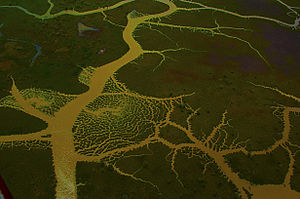Delta do Parnaíba Environmental Protection Area
| Delta do Parnaíba Environmental Protection Area | |
|---|---|
| Área de Proteção Ambiental Delta do Parnaíba | |
|
IUCN category V (protected landscape/seascape)
|
|

Parnaíba Delta
|
|
| Nearest city | Parnaíba, Piauí |
| Coordinates | 2°48′26″S 41°48′36″W / 2.807191°S 41.810116°WCoordinates: 2°48′26″S 41°48′36″W / 2.807191°S 41.810116°W |
| Area | 313,800 ha (1,212 sq mi) |
| Designation | Environmental protection area |
| Created | 28 August 1996 |
| Administrator | ICMBio |
The Delta do Parnaíba Environmental Protection Area (Portuguese: Área de Proteção Ambiental Delta do Parnaíba) is a federally-administered environmental protection area that covers parts of the coasts of the states of Maranhão, Piauí and Ceará, Brazil.
In Maranhão the Delta do Parnaíba Environmental Protection Area (APA) covers parts of the municipalities of Água Doce do Maranhão, Araioses, Paulino Neves and Tutóia. In Piauí the APA covers parts of the municipalities of Cajueiro da Praia, Ilha Grande, Luís Correia and Parnaíba. In Ceará the APA covers parts of the municipalities of Barroquinha and Chaval. It has a total area of 313,800 hectares (775,000 acres).
The APA contains the Delta do Parnaíba Marine Extractive Reserve. To the southeast it adjoins the federal Serra da Ibiapaba Environmental Protection Area. It adjoins the Lençóis Maranhenses National Park to the north and the Upaon-Açu/Miritiba/Alto Preguiças Environmental Protection Area to the west.
The Delta do Parnaíba Environmental Protection Area was created by federal decree on 28 August 1996 to protect the deltas of the Parnaíba, Timonha and Ubatuba Rivers, their fauna and flora and dune complex. It is classed as IUCN protected area category V: protected landscape / seascape. The APA aims to protect remnants of alluvial forest and water resources, and to improve the quality of life of the resident populations through guidance and discipline of economic activities. It also aims to promote ecological tourism and environmental education, and to preserve local cultures and traditions. It is administered by the Chico Mendes Institute for Biodiversity Conservation. The management plan was published in 1998. The consultative council was created on 10 December 2007.
...
Wikipedia

